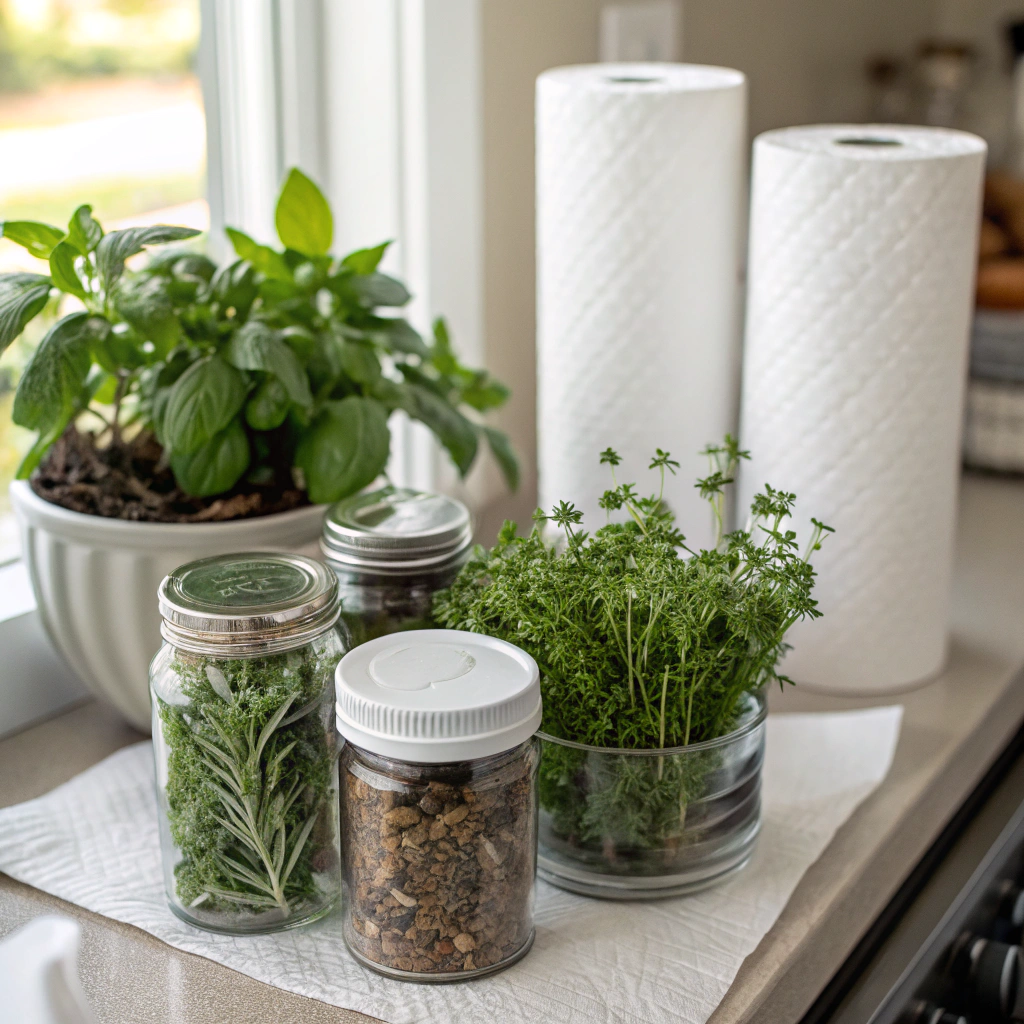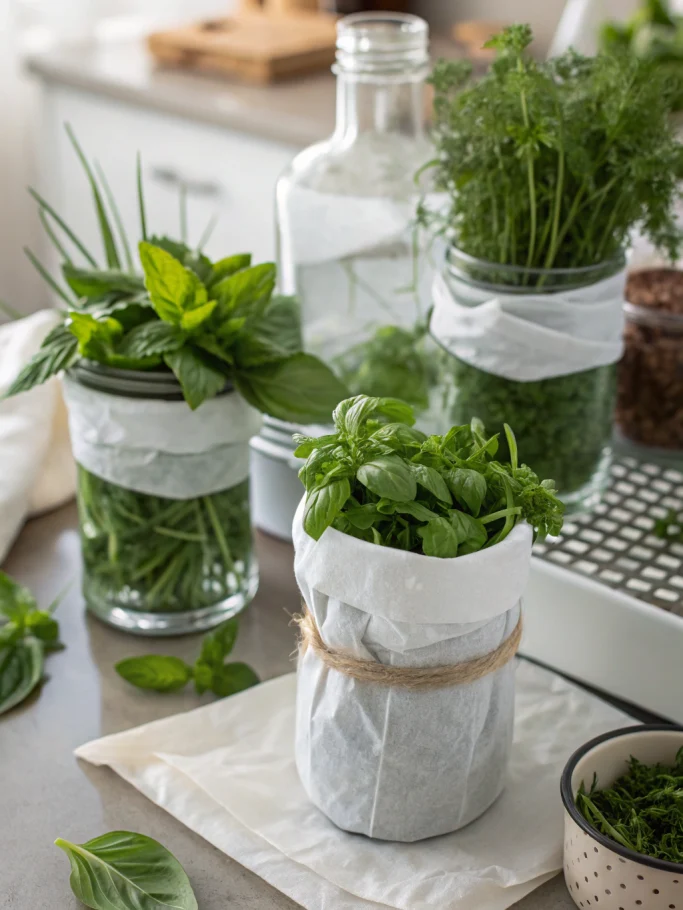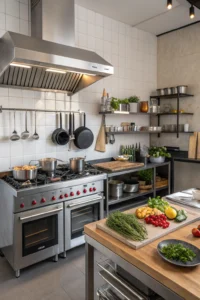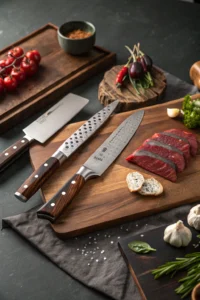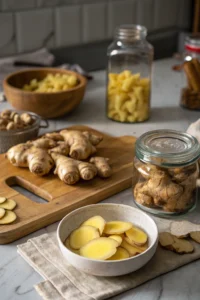Have you ever watched your beautiful fresh herbs wilt away in the fridge, despite your best efforts? As a home cook, I’ve learned that proper fresh herb storage is absolutely crucial for both flavor and value. Those fragrant basil leaves and delicate cilantro sprigs deserve better than becoming sad, slimy casualties in your produce drawer!
Through years of kitchen experiments and countless herb rescue missions, I’ve discovered foolproof methods that keep herbs crisp and vibrant for weeks. Whether you’re dealing with woody rosemary stems or tender parsley leaves, these game-changing storage techniques will help you say goodbye to herb waste forever.
Understanding Fresh Herb Storage Basics
Different Types of Herbs and Their Storage Needs
Fresh herb storage starts with knowing your herbs’ personalities. Tender herbs like mint, parsley, and cilantro need gentle handling and consistent moisture. Think of them as delicate flowers – they thrive with their stems in water, but their leaves need breathing room. On the flip side, hardy herbs like thyme, sage, and oregano have thick, sturdy leaves that prefer a drier environment. I learned this the hard way after storing my sage like basil – what a soggy mess!
Here’s a quick breakdown: soft herbs do best standing upright in jars with an inch of water, like a mini bouquet. Woody herbs prefer being rolled loosely in slightly damp paper towels. Both types need air circulation, so never pack them too tightly. And here’s my favorite kitchen hack: remove any bruised or yellowing leaves before storage – they’ll make the whole bunch spoil faster!
The Science Behind Herb Deterioration
Understanding fresh herb storage means knowing what makes herbs wilt and spoil. These green powerhouses naturally release ethylene gas as they age, which speeds up deterioration. Think of it like a domino effect – one aging leaf can trigger others to follow suit. Temperature fluctuations also play a huge role. When herbs go from cold to warm environments, condensation forms tiny water droplets that can lead to mold growth. I’ve noticed this happening when I take herbs straight from the fridge to my warm kitchen counter.
Light exposure is another sneaky culprit, breaking down chlorophyll and causing those vibrant leaves to fade. That’s why I always keep my herbs away from direct sunlight, even when they’re sitting pretty in their water jars. The key is maintaining steady conditions – consistent temperature, controlled moisture, and minimal light exposure.
Benefits of Proper Fresh Herb Storage
Mastering fresh herb storage transforms your cooking game while saving money. Fresh herbs can last up to three weeks when stored correctly, compared to just 3-4 days when neglected. I’ve found that properly stored basil adds vibrant flavor to my pasta dishes even after two weeks.
Beyond longevity, good storage preserves essential oils – the powerhouse behind those amazing flavors we love. You’ll notice the difference in your cooking, as preserved herbs release stronger aromas and deliver bolder tastes. Plus, you’ll reduce food waste significantly. Last summer, I started storing my herbs properly and cut my herb spending by half!
The nutritional benefits stay intact too. Vitamins A, C, and K remain stable when herbs are stored right. Think of proper storage as a way to keep your little green flavor bombs locked and loaded, ready to jazz up any dish at a moment’s notice.
Complete Step-by-Step Storage Guide
Initial Herb Preparation and Cleaning
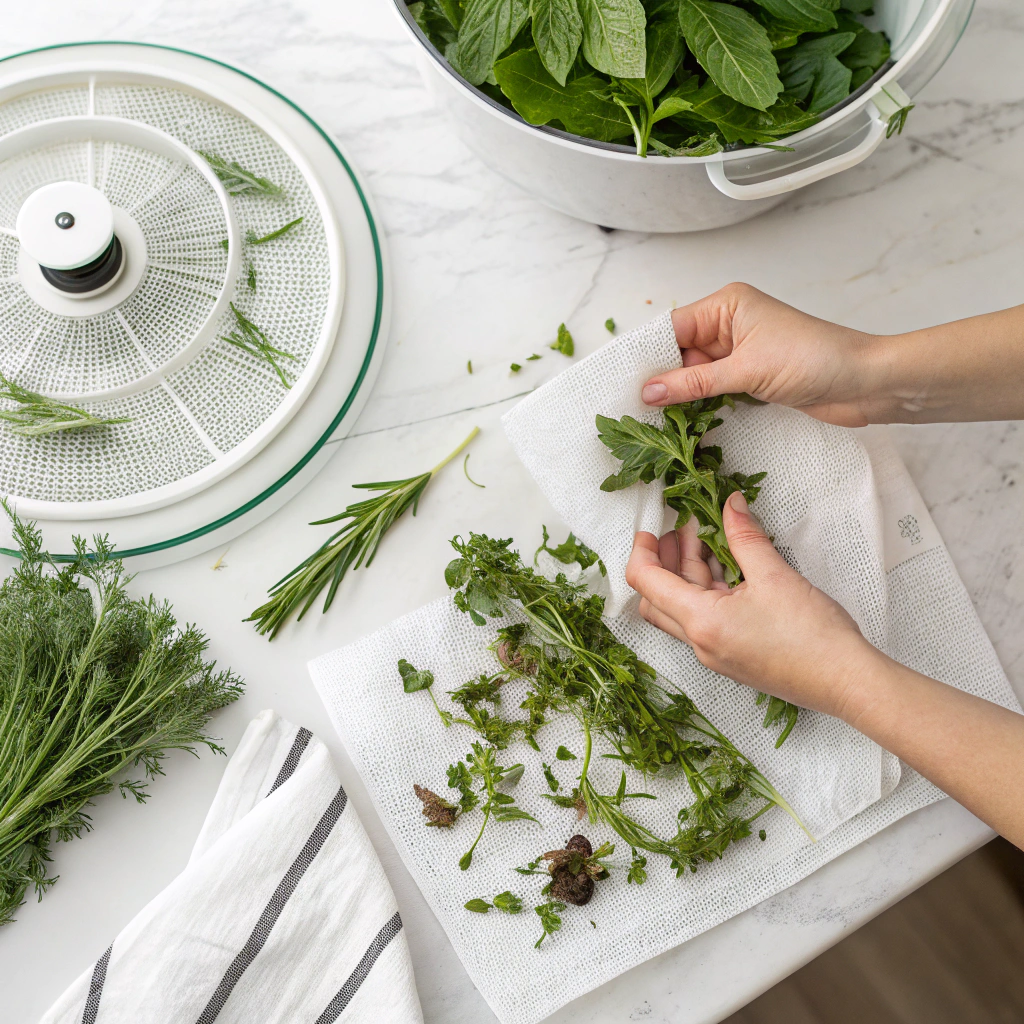
Fresh herbs deserve a proper welcome to your kitchen. Start by examining each bunch carefully, removing any wilted or yellowing leaves. Give them a gentle shake to dislodge hidden insects. Fill your sink with cool water and swish the herbs around – it’s like giving them a refreshing spa treatment! Pat them completely dry using paper towels or run them through a salad spinner.
This initial prep is crucial since excess moisture leads to rapid spoilage. I learned this the hard way when my basil turned to mush after storing it wet. Trim the stems at a 45-degree angle, just like you would with fresh flowers. This increases their surface area for water absorption if you’re planning to store them in water.
For leafy herbs like parsley and cilantro, remove any rubber bands or ties that could damage the stems.
Storage Methods for Different Herb Types
Different herbs need different storage approaches for maximum freshness.
Tender herbs like parsley, cilantro, and basil thrive with the jar method – pop them in a glass with an inch of water, like flowers in a vase. Cover loosely with a plastic bag and keep them on your counter, except for basil which hates the cold!
Hardy herbs like rosemary, thyme, and sage prefer the roll-up method. Wrap them in slightly damp paper towels, then tuck them into a zip-top bag with a few air holes poked in. The moisture level is key here – you want them just barely damp, not wet.
I’ve found changing the water every couple days for tender herbs and checking the paper towels weekly for hardy ones keeps everything crisp and flavorful. Think of it like giving your herbs a cozy little home where they can stay fresh and happy!
Tips for Storing Fresh Herbs in the Refrigerator
When it comes to keeping herbs fresh longer in your fridge, temperature zones matter big time! Most herbs do best in the middle shelves where temps stay steady around 40°F.
I’ve found that wrapping herbs in slightly damp (not wet!) paper towels before popping them in reusable produce bags works wonders. The towels give just enough moisture without making things soggy. Make sure to poke a few tiny holes in the bags for airflow – herbs need to breathe too!
One game-changing tip: sort your herbs by how long they typically last. Quick-to-wilt ones like cilantro and parsley should be front and center where you’ll see and use them first. Sturdier herbs like oregano can hang out in the back. Oh, and avoid storing herbs near ethylene-producing fruits like apples – they’ll make your herbs go bad faster!
Professional Storage Secrets
Humidity Management Techniques
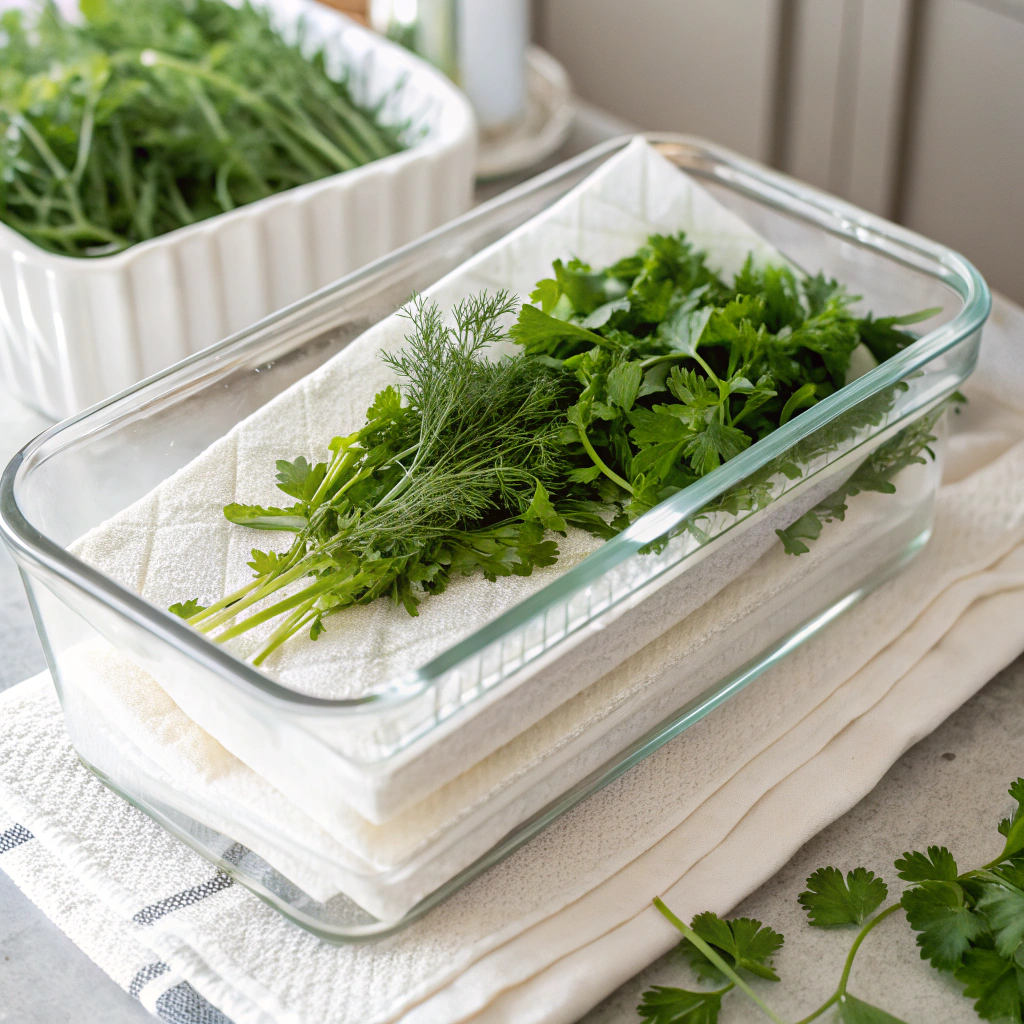
Creating the perfect moisture balance is crucial for herb longevity. The key lies in understanding that different herbs need varying humidity levels. Woody herbs like rosemary and thyme prefer slightly drier conditions, while tender herbs like basil and mint thrive with more moisture.
I’ve discovered that layering paper towels strategically makes all the difference – place one at the bottom of your container and another loosely on top of the herbs. This creates a microclimate that maintains just the right humidity. For delicate herbs, I mist the top paper towel lightly every few days.
A game-changing tip: use containers with adjustable vents or create your own by poking tiny holes in the lid. This allows excess moisture to escape while keeping enough humidity inside. Remember to check your herbs daily and remove any yellowing leaves that could increase moisture and lead to spoilage.
Temperature Control Secrets
Mastering temperature is crucial for fresh herb storage. I’ve found that most herbs thrive between 35-40°F – the sweet spot in your fridge’s crisper drawer. But don’t just toss them in! Place tender herbs like parsley and cilantro upright in a glass with an inch of water, like flowers in a vase. Then, loosely cover with a plastic bag to create a mini greenhouse effect. For woody herbs like thyme and rosemary, wrap them in slightly damp paper towels before placing them in a resealable bag.
A pro tip I swear by: keep herbs away from those cold spots where ice tends to form in your fridge. The back corners can sometimes dip below freezing, which turns herbs to mush faster than you can say “garnish.” Remember to check the temperature settings regularly – even small fluctuations can impact herb longevity.
Fresh Herb Washing Tips
Want the secret to truly clean herbs that last longer? Start by filling a large bowl with cold water and add a splash of white vinegar – this natural combo kills bacteria without affecting flavor. Gently submerge your fresh herbs and swish them around, letting any dirt sink to the bottom. I’ve learned that multiple short dunks work better than one long soak. After washing, use a salad spinner to remove excess moisture – wet herbs spoil faster! If you don’t have a spinner, gently pat them with paper towels, being careful not to bruise the delicate leaves.
Here’s a pro tip: wash woody herbs like rosemary and thyme separately from tender ones like basil and cilantro. They need different handling, and mixing them can lead to damaged leaves. Remember, clean herbs are happy herbs, and happy herbs mean better-tasting dishes!
Solving Common Storage Problems
Preventing Early Wilting and Decay
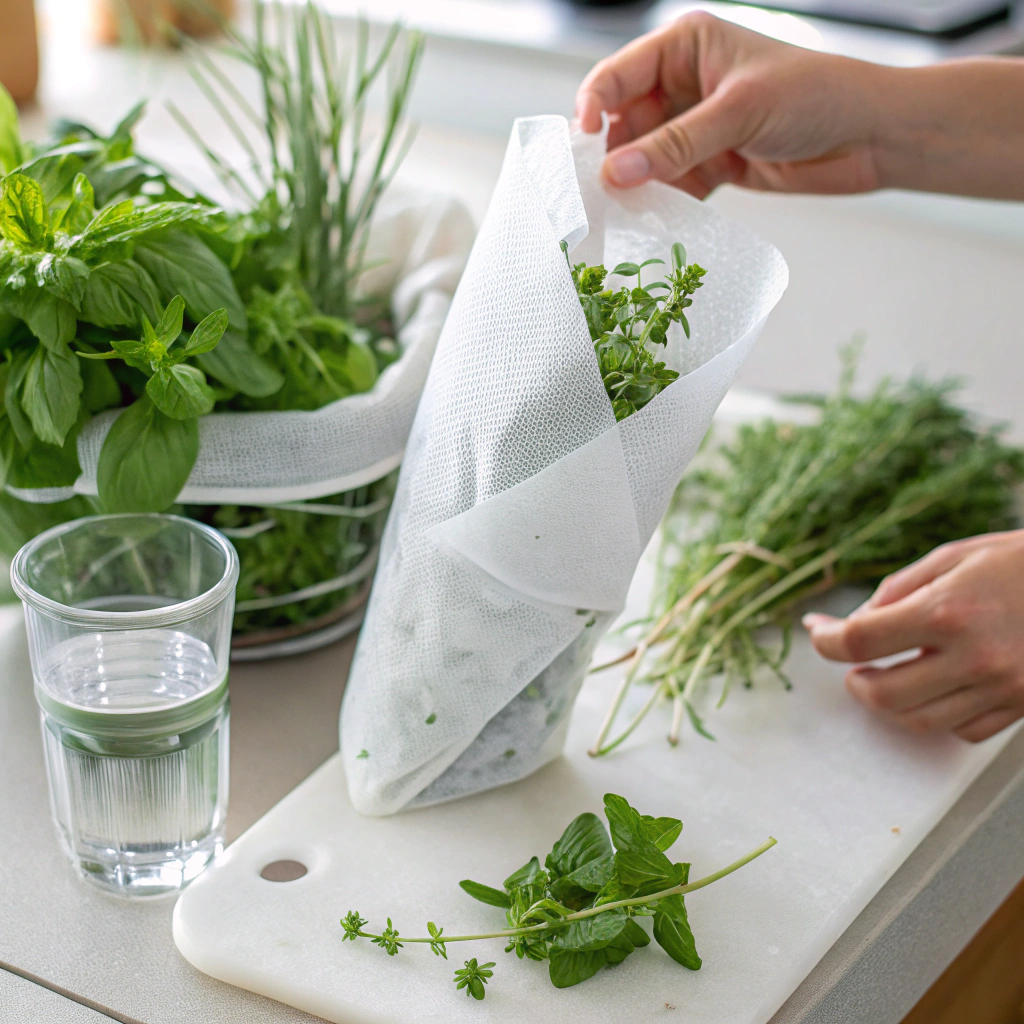
Want to keep those pricey fresh herbs from turning into a slimy mess? The secret lies in creating the perfect moisture balance. Think of herbs like tiny houseplants – they need just the right environment to thrive. I’ve found that wrapping herbs in slightly damp paper towels before placing them in a resealable plastic bag works wonders. But here’s my game-changing tip: add a few small holes in the bag for airflow! Those tender herbs like basil and parsley stay perky for up to two weeks this way.
For woody herbs like rosemary and thyme, stand them upright in a glass with an inch of water, like a mini bouquet. Pop a loose plastic bag over the top, and they’ll stay fresh for ages. Just remember to change the water every few days – stagnant water is a fast track to spoilage!
Using Freezer Storage for Long-Term Preservation
Here’s a game-changing tip for those pricey fresh herbs – freeze them! I’ve found that chopping herbs finely and mixing them with a splash of olive oil creates perfect little flavor bombs. Spoon this mixture into ice cube trays, freeze until solid, then pop them into freezer bags. These frozen cubes work brilliantly in soups, stews, and sauces.
For leafy herbs like basil and cilantro, try flash-freezing whole leaves on a baking sheet before transferring to containers. This prevents them from clumping together and lets you grab just what you need. My favorite discovery? Frozen herbs actually retain more flavor than dried ones!
Just remember to label everything with dates – while they’ll stay good for months, they’re best used within 6-8 weeks for optimal taste. The texture won’t be quite right for garnishing, but they’re perfect for cooking.
The Paper Towel Method for Extended Freshness
Here’s my favorite trick for keeping herbs fresh longer – the paper towel method! Gently wash your herbs, then pat them completely dry. Wrap them loosely in slightly damp paper towels, being careful not to crush those delicate leaves. Pop them into a resealable plastic bag, but leave it partially open to allow some airflow. Before you zip it up, gently squeeze out excess air. This creates the perfect humid environment herbs love.
I’ve found this works amazingly well for parsley, cilantro, and dill – they stay perky for up to two weeks! Just remember to check the paper towels every few days and replace them if they get too wet. This prevents any unwanted moisture buildup that could lead to wilting.
The key is finding that sweet spot between too dry and too damp. Trust me, once you master this technique, you’ll never go back to just tossing herbs in the fridge!
Creative Storage Methods for Fresh Herbs
Refrigerator Storage Solutions
Got fresh herbs from the garden? The refrigerator is your best friend for long-term storage, but there’s a trick to it. Start by selecting the coldest spot in your fridge – usually the back of the bottom shelf where temperatures stay most consistent. Create a mini greenhouse effect by placing your herbs upright in a glass jar with about an inch of water, just like you would with fresh flowers.
For tender herbs like basil and cilantro, loosely cover with a plastic bag to trap humidity while still allowing some airflow. This method works beautifully with our Mediterranean Chickpea Salad, where fresh herbs really shine.
Change the water every few days and trim the stems if they start looking brown. With proper temperature control around 40°F (4°C), your herbs can stay vibrant for up to three weeks!
Freezer Storage for Long-Term Preservation
Want to keep those herbs fresh for months? The freezer offers an amazing solution for long-term storage. Start by washing and thoroughly drying your herbs, then chop them into useable portions. Here’s a game-changing trick: spread the chopped herbs in ice cube trays, fill with olive oil, and pop them in the freezer. Once frozen, transfer these herb-filled cubes to freezer bags – they’ll keep their flavor for up to 6 months!
Another nifty method is creating herb paste: pulse clean herbs with a splash of water in a food processor, then freeze in tablespoon-sized portions using an ice cube tray. Label everything clearly with dates and herb types.
When you’re ready to cook, just drop a cube straight into your simmering soup or sauce. These frozen herbs work wonderfully in cooked dishes, though they won’t give you that fresh garnish look.
Refrigerator Storage for Daily Use
Fresh herbs can stay vibrant in your fridge with the right storage method. Start by gently washing herbs in cool water and patting them completely dry. For soft herbs like basil, cilantro, and parsley, trim the stems and stand them upright in a jar with about an inch of water, just like a bouquet. Cover loosely with a plastic bag and store in the fridge.
Hard herbs like rosemary, thyme, and sage prefer a different approach – wrap them in slightly damp paper towels, then place in a resealable plastic bag with a bit of air inside. Keep them in your crisper drawer where they’ll stay fresh for up to two weeks.
Remember to change the water for soft herbs every few days and check regularly for any wilted leaves. These simple storage tricks will keep your herbs fresh and ready to add that perfect flavor punch to your cooking.
Start Storing Your Herbs Today
Don’t let another bunch of herbs wilt away! Transform your kitchen into an herb-saving haven with these proven storage methods. Your future self will thank you when reaching for perfectly preserved herbs while cooking. Remember, proper storage means less waste and more flavor in every dish. Ready to get started? Grab those fresh herbs and give them the care they deserve!
